Best Orthotics for Hypermobility – Improve Your Child’s Stability and Reduce Fatigue and Pain!

Has your child been diagnosed with hypermobility leading your medical professional to recommend orthotics? Children with hypermobility tend to have stability issues and experience fatigue, foot pain, and leg pain. The first seven years of a child’s life are often referred to as the “golden years of treatment opportunity.” During this time, permanent structural changes of the foot and lower extremity may be relatively easy to obtain with treatments such as supportive shoes and orthotics. The orthotics I recommend for hypermobility can help align your child’s feet by improving your child’s walking gait and overall posture.
Assisting Kids with Hypermobility – Over a Decade of Experience
As a shoe fitter who works closely with physical therapists (PTs) and occupational therapists (OTs), I have had the privilege of helping countless families find the right orthotics for hypermobility. Each child presents a unique set of challenges, and understanding these is key to providing effective solutions.
Before and After: The Impact of Orthotics
The transformation that orthotics can provide is often remarkable. In before and after images, you can see the difference in alignment and posture, which translates into improved comfort and reduced pain.
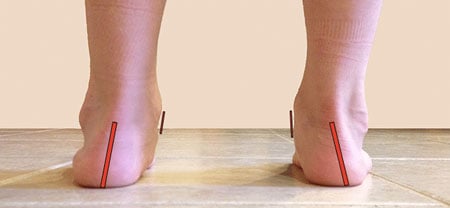
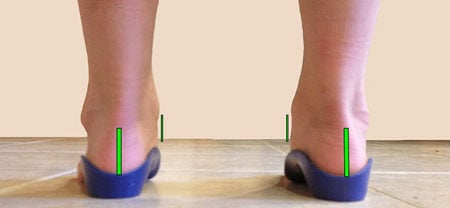
The Importance of Supportive Orthotics
Supportive orthotics can be life-changing for children with hypermobility. They provide additional stability, improve alignment, and reduce strain on the joints. Orthotics work by supporting the natural structure of the foot, which can help mitigate the excessive motion seen in hypermobile joints. This support not only alleviates pain but also enhances overall movement efficiency, making daily activities less tiring for the child.
Common Signs a Child Might Have Hypermobility
Many parents of children with hypermobility tell me their children prefer to sit or be lifted instead of walking independently. Some families of older children tell me how their children have a disinterest in physical activities such as playing sports. While some families believe these behaviors are due to their child being lazy, they are also common signs of hypermobility. I always suggest that families take their children to be evaluated further by their medical professionals.
Key Features of Pediatric Orthotics
I recommend the least restrictive orthotic for children with hypermobility as they allow for foot mobility along with stabilization.
1. Deep Heel Cup: The 30mm heel cup in LittleSteps orthotics helps to stabilize the heel and control excessive motion. This feature is crucial for children with hypermobility as it aids in maintaining proper alignment and reducing strain on the joints. By cradling the heel securely, the heel cup minimizes undue stress on the ankles and knees, which are often affected by hypermobility.
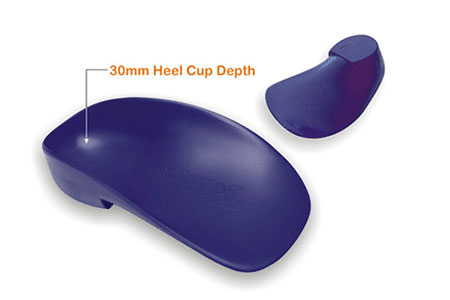
2. Medial and Lateral Flanges: This feature provides additional support on the sides of the foot, which is particularly beneficial for children with flat feet or pronation issues often associated with hypermobility. These flanges help guide the foot into a more neutral position, promoting better balance and function. By encouraging a more aligned gait, these features can significantly reduce discomfort and enhance mobility.
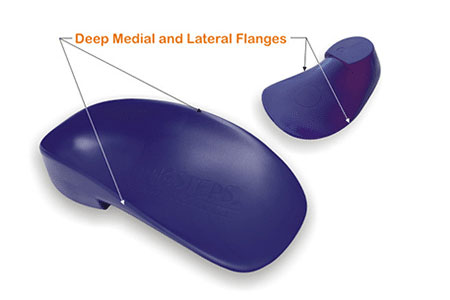
In the correct pair of shoes and orthotics, children with hypermobility should see a clear improvement in their walking gait. Their walking gait should become more synchronized, with a reduction in their step length and width variability.
Best Orthotics for Hypermobility to Reduce Pain and Improve Stability
This is the best prefabricated orthotic on the market for helping to treat and control hypermobility. This orthotic will help correct your child’s foot posture and provide extra stability around the ankles.
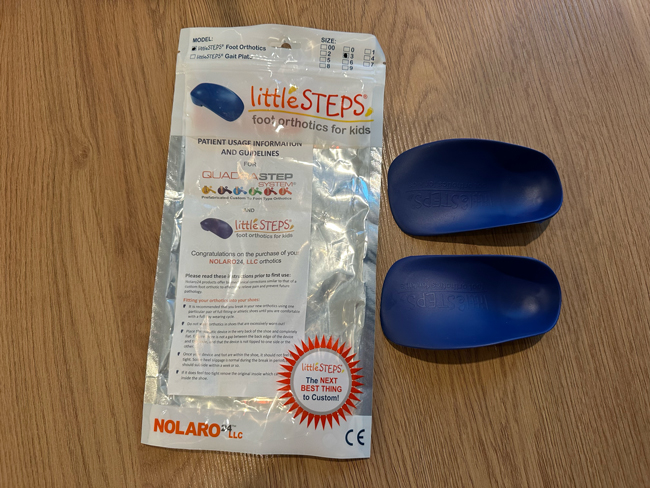
- Order littleSTEPS® Orthotics from their official website. You must submit a Referral Code to complete your order: JVFCS100121
- It’s not necessary to remove the original insoles of the shoes when fitting this orthotic.
- The 3/4 length design makes it easier to fit into various shoe styles.
- Take a look at this chart to figure out what size to order based on your child’s shoe size.
Access My Resource on Supportive Shoes for Orthotics
The goal of providing your child with the correct pair of shoes is to stabilize their joint function and prevent foot injuries. We need to look for shoes that provide substantial outsoles, firm heel counters, and straight lasts.
I created a comprehensive resource on supportive shoes for orthotics. This resource is designed to help parents determine the best shoe options for their children and ensure a proper fit that complements the orthotics. The guide includes insights into different brands, fitting tips, and considerations for specific conditions.
Contact Me for Specific Orthotic and Shoe Recommendations
I am committed to helping families find the right solutions for their children’s foot health and am happy to provide personalized guidance based on your child’s unique needs. Understanding that each child’s situation is different, I take the time to assess and recommend the most suitable option, so feel free to reach out to me via email.
Additional Resource: How to Tie Your Kids’ Shoes with Orthotics
A well-tied shoe will keep the orthotic in place and prevent unnecessary shifting during activities, maintaining optimal support throughout the day. I suggest that you apply the following shoe lacing technique once you fit an orthotic inside your child’s shoes.
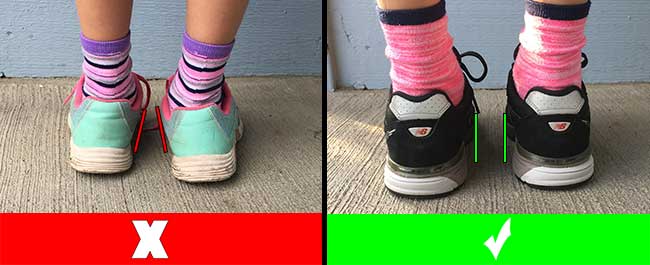
My Take on Diagnosing Children with “Growing Pains”
It is very important that a child’s foot or leg pain is not simply passed off as “growing pains”. Most of the time there is a reason why your child is complaining about having pain. Many children can have foot or leg pain due to a foot condition that has been ignored. If your doctor diagnoses your child’s foot or knee pain as growing pains you may want to seek clarification or a further evaluation to ensure there is no underlying problem causing the pain.
If your child expresses foot or leg pain, try to find the source of their pain promptly, as many foot and leg conditions get worse without treatment. Keeping children involved with physical activity is extremely important for their health, and a treatable foot condition may be the cause of their reluctance to participate in such exercises. Furthermore, the correct type of shoes and orthotics will help reduce the likelihood of your child developing foot, knee, hip and/or lower back pain as they get older.
You can unquestionably better a child’s life by fitting them in the correct pair of shoes and orthotics for hypermobility.
“Hypermobile Joints.” Nationwide Children’s Hospital, www.nationwidechildrens.org/conditions.hypermobile-joints.
“Joint Hypermobility.” Versus Arthritis, www.versusarthritis.org/about-arthritis/conditions/joint-hypermobility/.

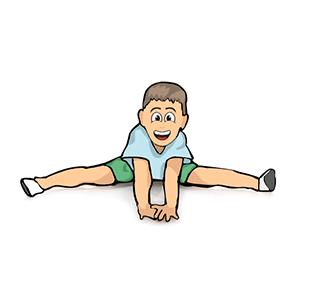
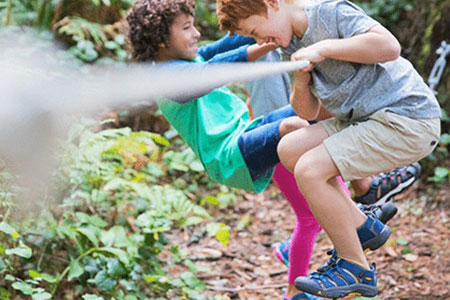
My nephew has this problem and we all thought it was gonna go away as he grows. He has been having stability issues lately so I am hoping this orthotic will help him with his balance. Is this the best orthotic for hypermobility or do you think there is another one that might work better? My nephew has flat feet.
Hello Jim,
Children with hypermobility tend to have stability issues, and they also tend to experience fatigue and foot or leg pain. This is the most effective orthotic I have tried for children with hypermobility. This doesn’t mean that there might be a better orthotic out there, but I have seen several hypermobile children benefit from wearing this orthotic. Their balance and walking gait was significantly improved.
I think that you should know that my friends child’s foot posture and walking gait has improved significantly from wearing the orthotics and shoes you recommend. I am glad I found your website I have been spreading the word about it as I think a lot of parents don’t now about it yet. Keep up the good work!
Hello Abel,
I am happy to hear that!